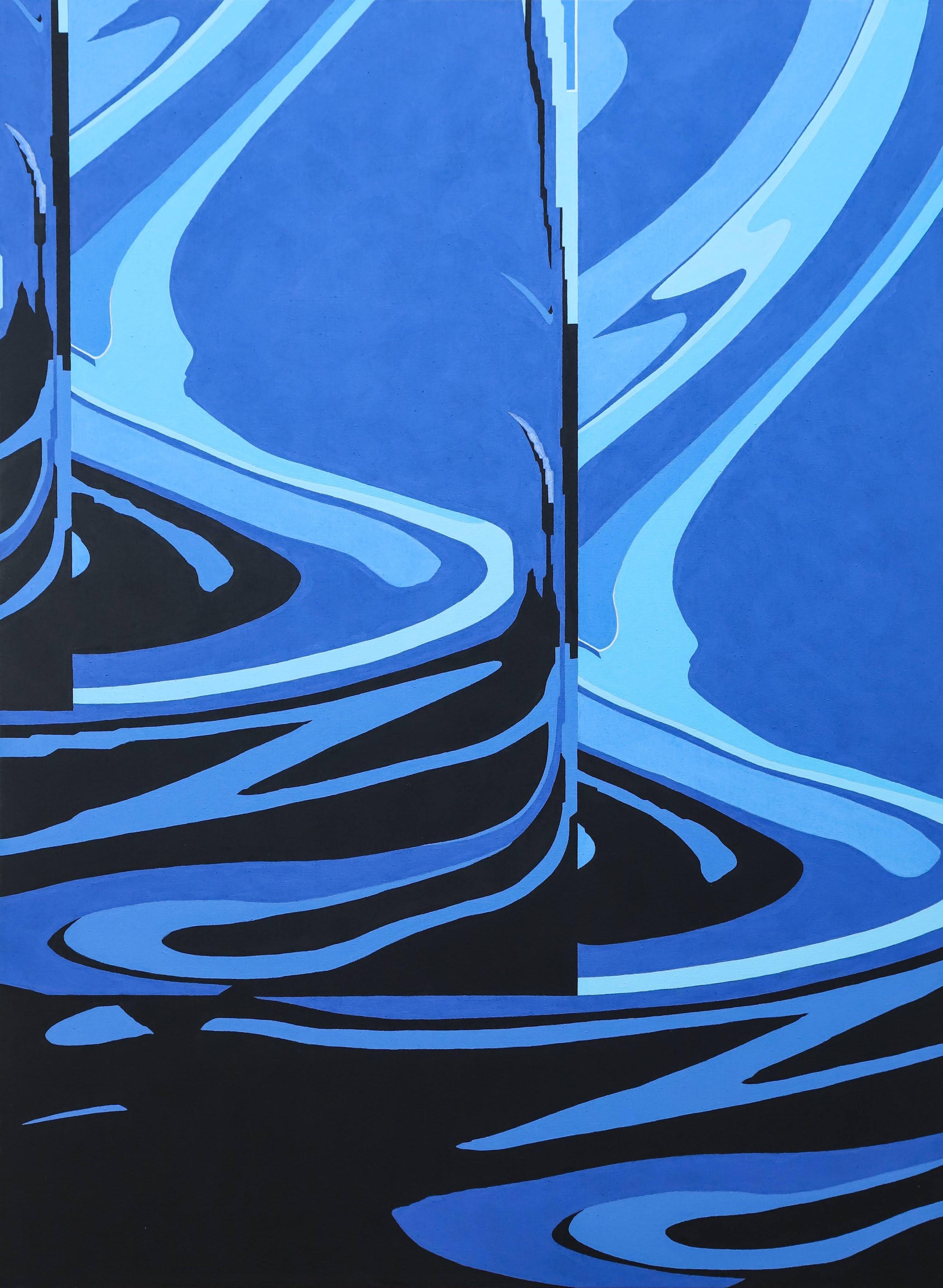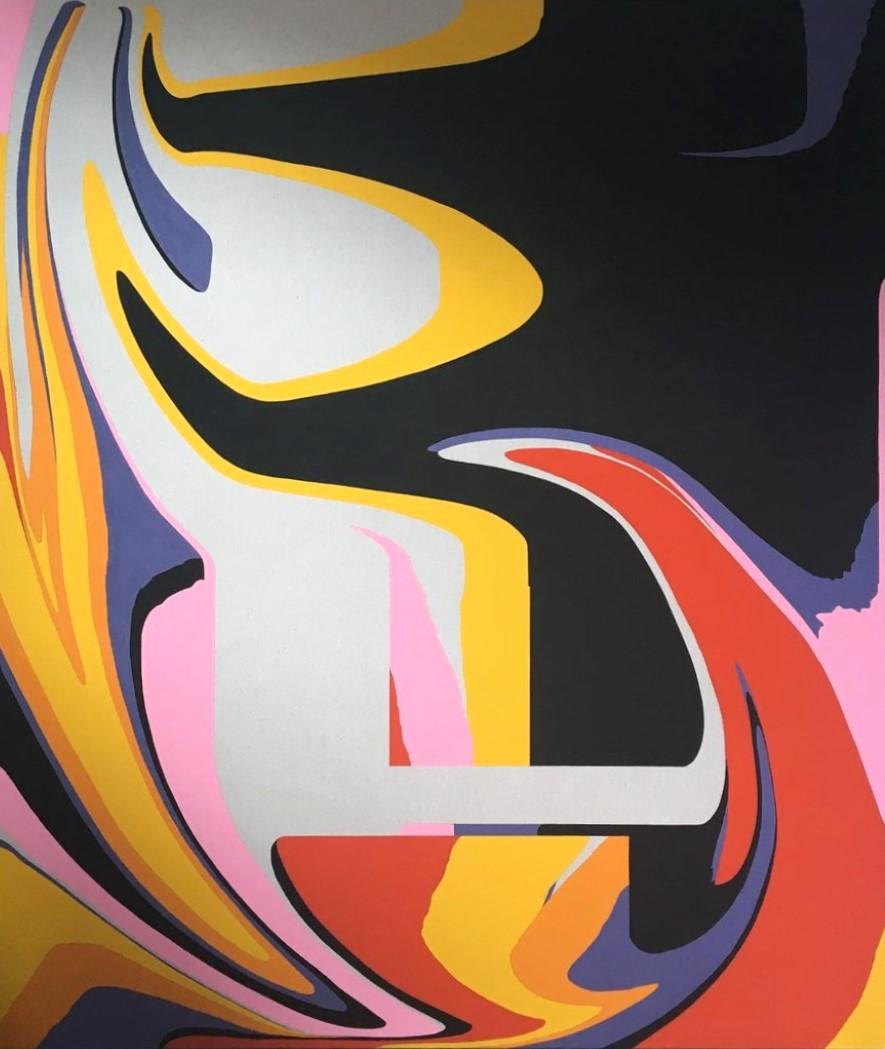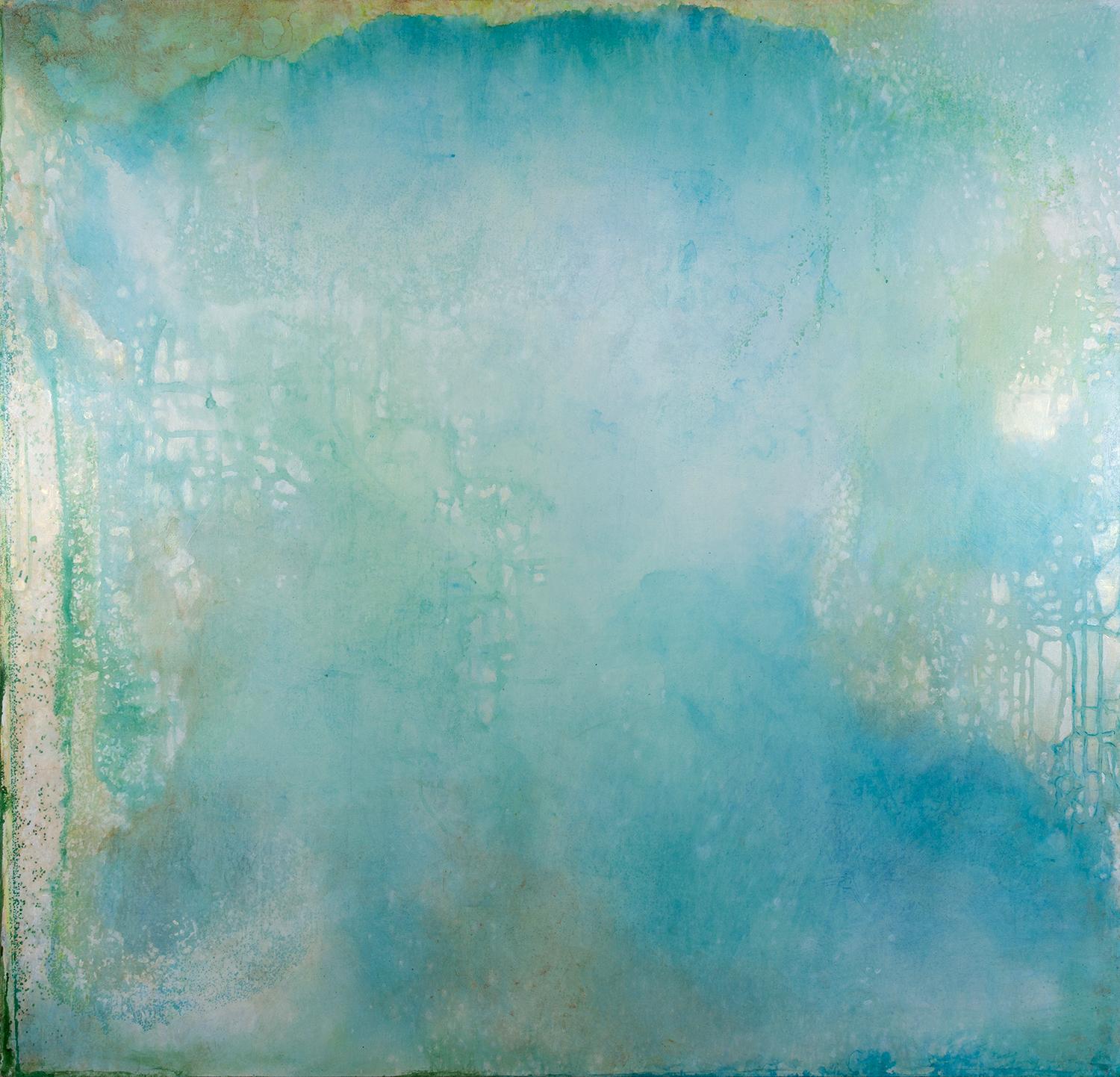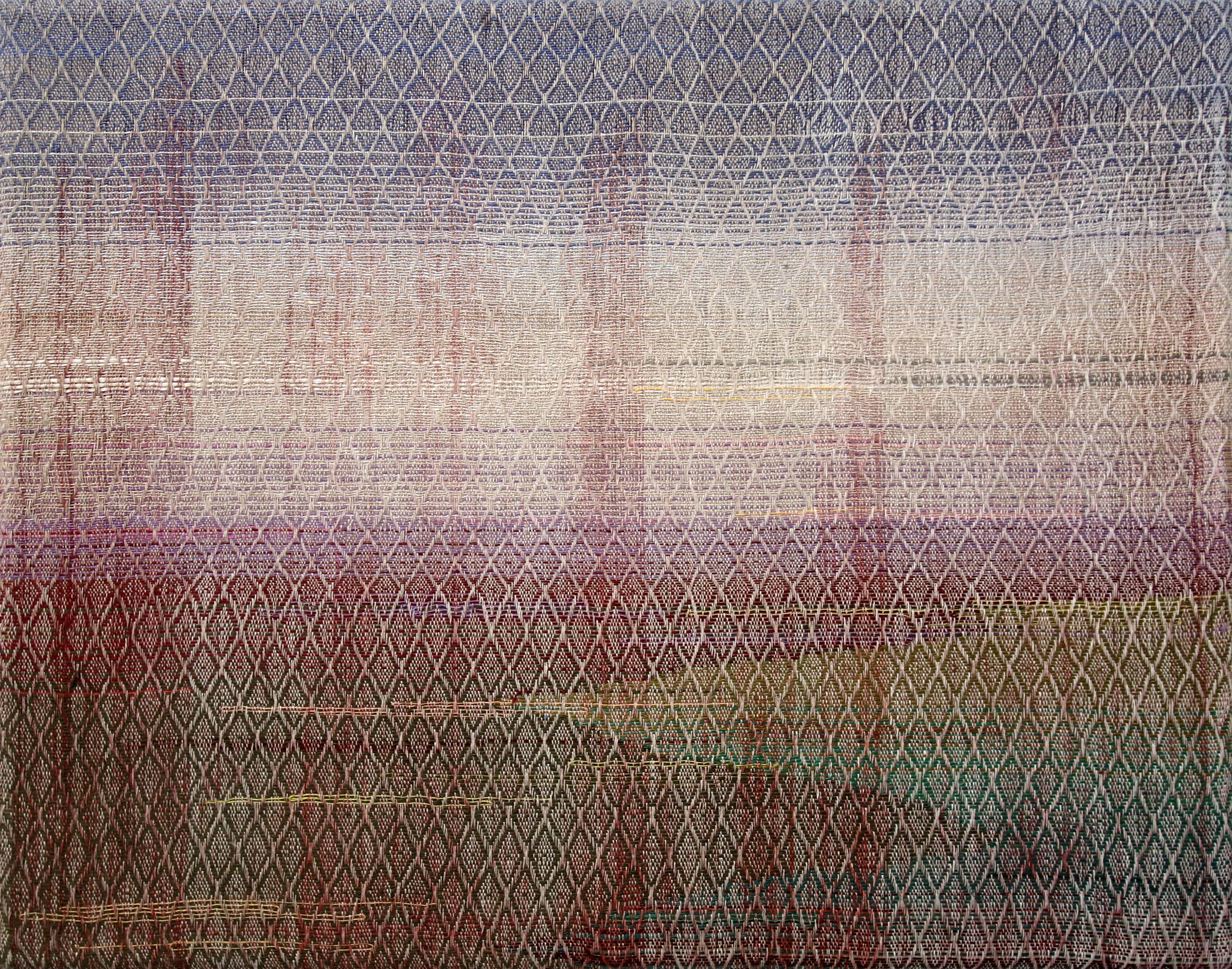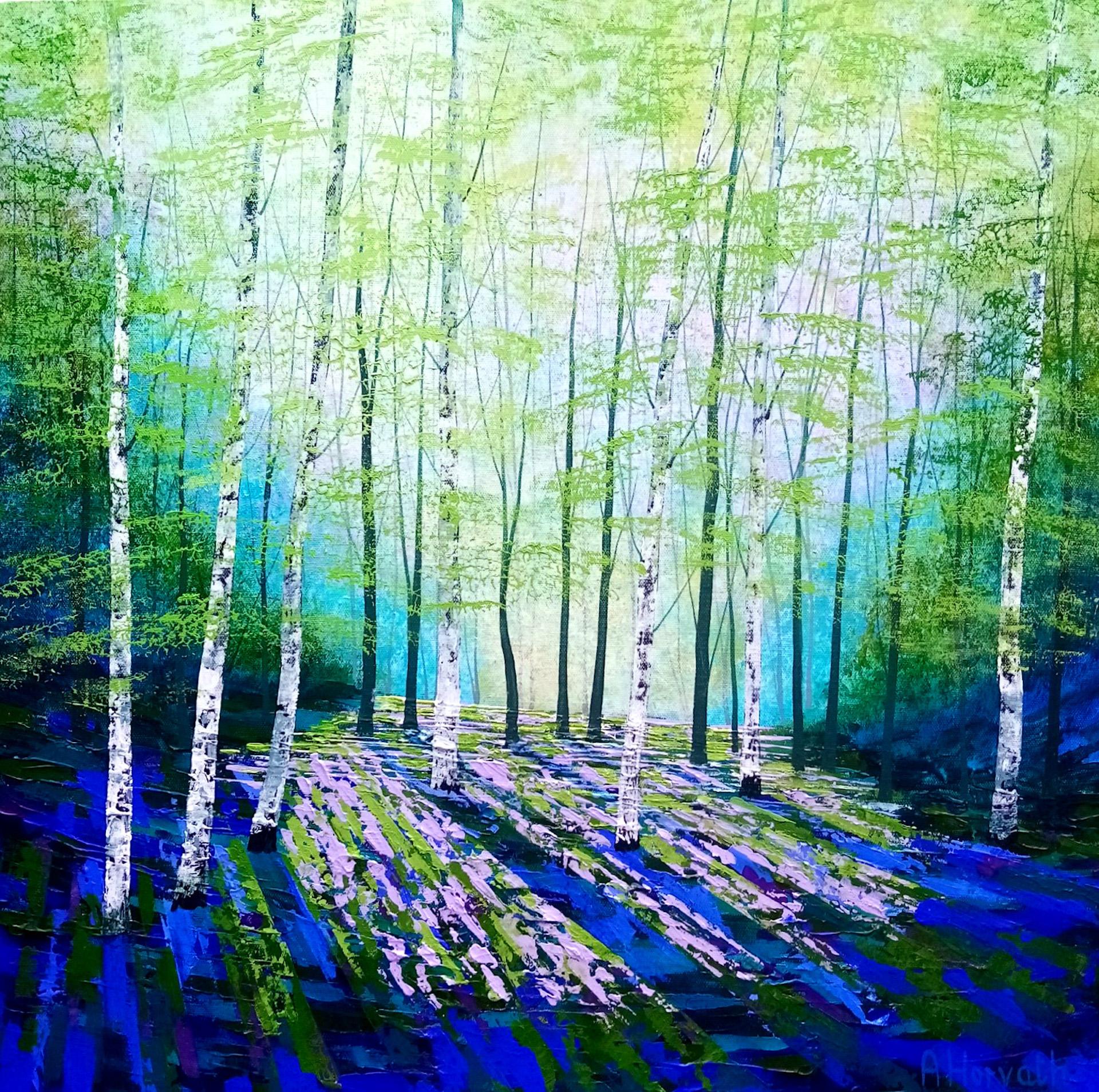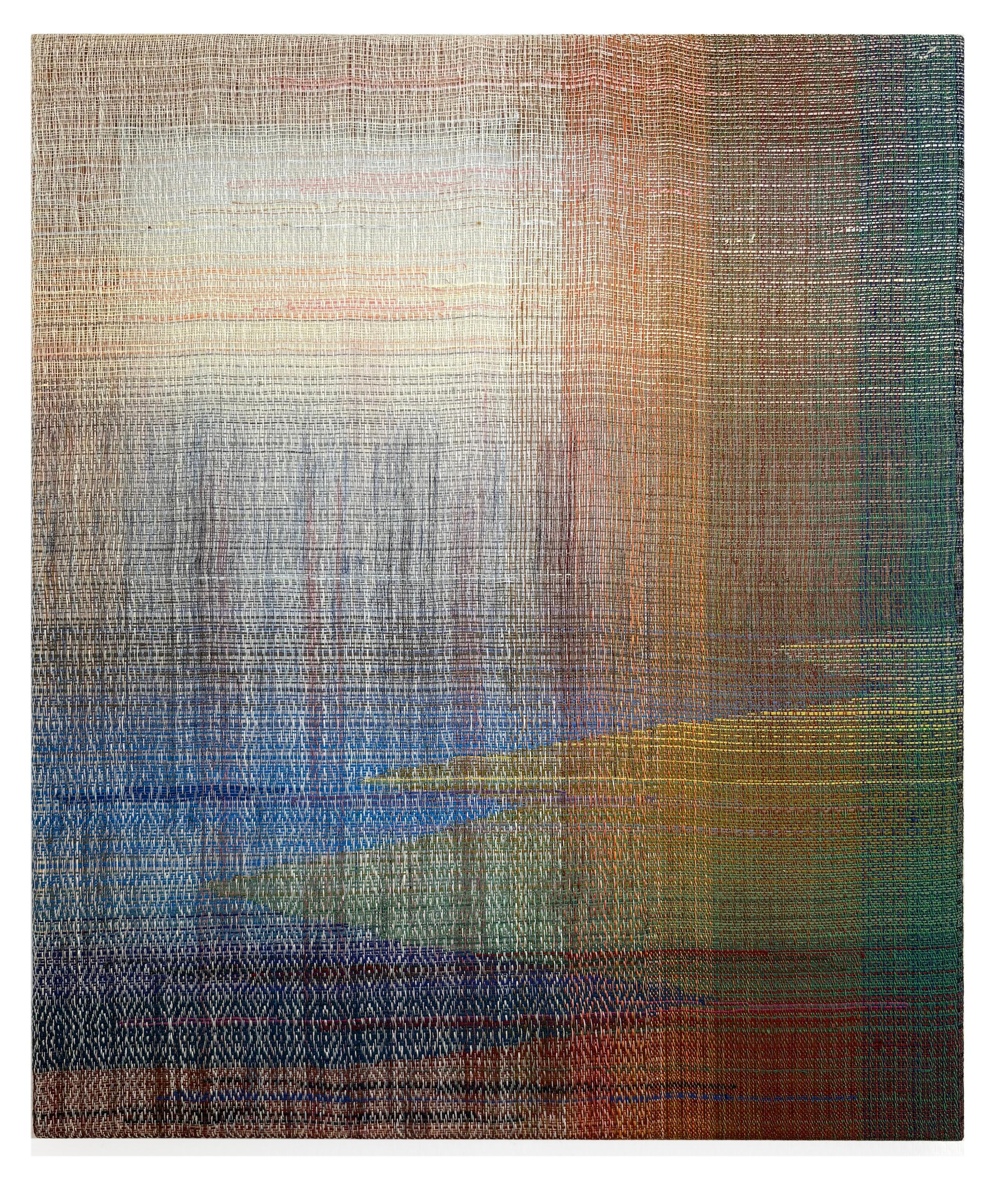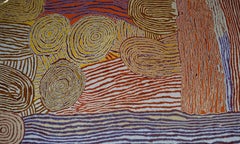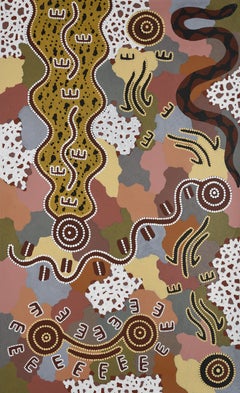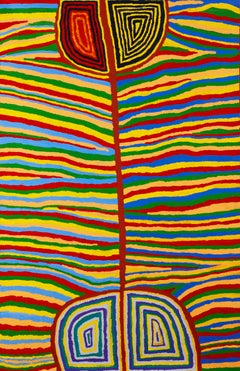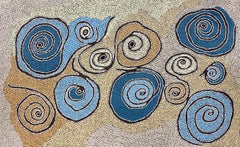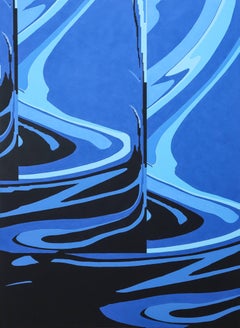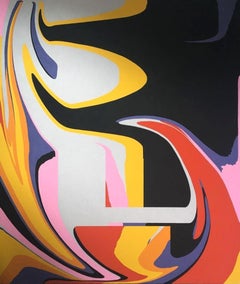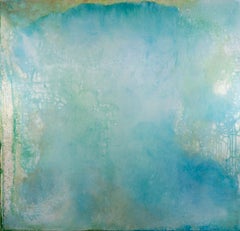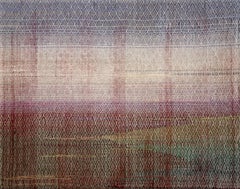Items Similar to Aboriginal Painting by George Ward Tjungurrayi
Want more images or videos?
Request additional images or videos from the seller
1 of 12
George Ward TjungurrayiAboriginal Painting by George Ward Tjungurrayi2014
2014
About the Item
George Ward Tjungurrayi was born near Kiwirrkura. It was only in his teenage years that he first encountered Europeans, when a commonwealth welfare patrol came upon his family group camped by a desert waterhole. After travelling to the government settlement at Papunya, first home of the desert painting movement,
George Ward worked briefly as a fencer and a butcher in the community kitchen. He began painting for the Papunya Tula Artists in about 1976. His country covers the sites around Wala Wala, Kiwirrkura, Lake Mackay, Kulkuta, Karku, Ngaluwinyamana and Kilpinya to the north-west of Kintore across the West Australian border.George paints the Tingari stories for this region.
In 2004 George Ward Tjungurrayi won the 2004 Wynne Art Prize at the Art Gallery of New South Wales for his topographical depiction of the Western Desert. He has also exhibited in many galleries throughout Australia and worldwide. His works are highly sought after by collectors.
- Creator:George Ward Tjungurrayi (1945, Aboriginal Australian)
- Creation Year:2014
- Dimensions:Height: 47.25 in (120 cm)Width: 35.44 in (90 cm)
- Medium:
- Movement & Style:
- Period:
- Condition:
- Gallery Location:Miami, FL
- Reference Number:1stDibs: LU13612675272
About the Seller
5.0
Gold Seller
Premium sellers maintaining a 4.3+ rating and 24-hour response times
Established in 2011
1stDibs seller since 2012
73 sales on 1stDibs
Typical response time: 1 hour
- ShippingRetrieving quote...Shipping from: Les Adrets-de-l'Estérel, France
- Return Policy
Authenticity Guarantee
In the unlikely event there’s an issue with an item’s authenticity, contact us within 1 year for a full refund. DetailsMoney-Back Guarantee
If your item is not as described, is damaged in transit, or does not arrive, contact us within 7 days for a full refund. Details24-Hour Cancellation
You have a 24-hour grace period in which to reconsider your purchase, with no questions asked.Vetted Professional Sellers
Our world-class sellers must adhere to strict standards for service and quality, maintaining the integrity of our listings.Price-Match Guarantee
If you find that a seller listed the same item for a lower price elsewhere, we’ll match it.Trusted Global Delivery
Our best-in-class carrier network provides specialized shipping options worldwide, including custom delivery.More From This Seller
View AllTjintjintjin
By Walangkura Napanangka
Located in Miami, FL
As one of the last generation to remember a childhood lived in the desert hunting and gathering with her family, Walangkura Napanangka's paintings recall the stories of country and the location of specific sites in her traditional homeland west of the salt lake of Karrkurutinjinya (Lake Macdonald).
Born around 1946, at Tjitururrnga west of Kintore, in the remote and arid country between the Northern Territory and Western Australia, she lived with her father Rantji Tjapangati and mother Inyuwa Nampitjinpa and later, while still a teenager, travelled by foot with her family over the hundreds of kilometres from their remote desert home eventually joining Uta Uta Tjangala's group as they walked in to the settlements of Haasts Bluff and then Papunya.
The lure of settlement life with its promise of plentiful food and water belied the harsh conversion they would make to an alien lifestyle with its many problems and unfamiliar demands. The upheaval however, was ameliorated to some degree by the proximity of her immediate family including her mother Inyuwa, adoptive father Tutuma Tjapangati, and sister Pirrmangka Napanangka (now deceased) all of whom became artists.
Relocated to the community of Kintore in 1981 when the outstation movement began, Walangkura participated in the historic women's collaborative painting project (1994) that was initiated by the older women as a means of re-affirming their own spiritual and ancestral roots. It was a time of specifically female singing, ceremony and painting, away from the gaze of outsiders and men folk. The huge and colourful canvases that emerged from the women's camp were 'alive with the ritual excitement and narrative intensity of the occasion' (Johnson 2000: 197).
Within a year, Papunya Tula Artists, now established at Kintore, had taken on many of these women as full-time artists, revitalising the company after the deaths of many of the original 'painting men'. While individual women forged their own stylistic trajectory, these paintings were immediately distinguishable from the men's more cerebral and symmetrical style. They radiated an exuberant and vibrant energy, the felt heart-beat of women's affinity to country and spirit.
Walangkura's early works, created from 1996 onward, are characterized by masses of small markings and motifs covering large areas of canvas. Her favorite colour, a deep sandy orange predominates, accentuated against more somber blacks and reds and dusky greens or yellows. More recent works show a gestural quality though still tightly packed with an intensity of geometric line work representing sandhills. In a sense this provides a strong visual and contextual link to the men's linear style as exemplified by the works of George Tjungurrayi...
Category
2010s Contemporary Abstract Paintings
Materials
Linen, Cotton Canvas, Acrylic
Aboriginal Painting by Michael Nelson Tjakamarra
By Michael Nelson Tjakamarra
Located in Miami, FL
Michael Nelson Tjakamarra (also cited as: Michael Nelson Jagamarra, or Jakamara) is a Senior Warlpiri Tribesman and an Elder of the Papunya Community in central Australia. Born c. 19...
Category
2010s Contemporary Abstract Paintings
Materials
Linen, Acrylic
Hairstring
Located in Miami, FL
Judy Watson Napangardi was born around 1935 at Yarungkanji, Mt. Doreen Station, at the time when many Warlpiri and other Central and Western Desert Peoples were living a traditional ...
Category
2010s Contemporary Abstract Paintings
Materials
Linen, Acrylic
My Grandmother's Country
Located in Miami, FL
Maureen Baker lives in Warakurna, an Indigenous community nestled in the Rawlinson Ranges, approximately 330km west of Uluru.
Maureen is a creative and...
Category
2010s Contemporary Abstract Paintings
Materials
Linen, Cotton Canvas, Acrylic
Pikarli - My Country
By Yannima Tommy Watson
Located in Miami, FL
Yannima Tommy Watson is a Pitjantjatjara artist born around the 1930s, in the bush some 44km west of the small isolated community of Irrunytju. Not yet very well known to the French public, despite his participation in the architectural project of the Musée du Quai Branly, Tommy Watson is nevertheless often considered the greatest living Aboriginal artist.
Like many aborigines of his generation, he lived a traditional, nomadic or semi-nomadic life before his contact with Western civilization; then he will occupy the only jobs that the Aborigines find: herdsmen (until Yuendumu), laborers for the construction of infrastructures in the desert. Throughout this period he became familiar with his "country", a harsh region, and deepened his knowledge, both profane and sacred, relating to Dreams and Dreamtimes, to the connections between sacred sites and the Ancestors. He will even work in Papunya, where the artistic movement started. But the Pijantjarra are intransigent with tradition…no question at this time of revealing the motives and the secret stories.
The North of South Australia, the region where he is from, was touched by the pictorial movement only at the very beginning of the 2000s. In 2001, Tommy began his career as an artist in Irrunytju (Wingellina). He is a young artist… He learns by observing other painters and draws on the experiences of a long life and on the exceptional knowledge he has stored up. But quickly he will find his way, a radically new style where color plays a major role. Very quickly, the iconography now well known by the artists of Yuendumu, or the Western Desert, Balgo or Lajamanu disappeared. The symbols are no longer there. As Rover Thomas, Emily Kame or Paddy Bedford had done before him, this is a real artistic revolution. For Tommy, it is not a question of describing his Dream (Caterpillar), the routes taken by the Ancestors. He concentrates on a site, a story, sometimes very profane, the memory of a meeting, of a hunting party, tries to condense his memories, the information of which he is the depositary, to add a poetic touch to it, sometimes melancholy, and this gives a painting with a very abstract aspect. It is a painting where the emotion is very present, undoubtedly less cerebral than the art of the neighbors of the north the Pintupi, like Ronnie Tjampitjinpa, George...
Category
2010s Contemporary Abstract Paintings
Materials
Cotton Canvas, Acrylic, Linen
Ngayuku Kgura (My Country)
By Yannima Tommy Watson
Located in Miami, FL
Yannima Tommy Watson is a Pitjantjatjara artist born around the 1930s, in the bush some 44km west of the small isolated community of Irrunytju. Not yet very well known to the French public, despite his participation in the architectural project of the Musée du Quai Branly, Tommy Watson is nevertheless often considered the greatest living Aboriginal artist.
Like many aborigines of his generation, he lived a traditional, nomadic or semi-nomadic life before his contact with Western civilization; then he will occupy the only jobs that the Aborigines find: herdsmen (until Yuendumu), laborers for the construction of infrastructures in the desert. Throughout this period he became familiar with his "country", a harsh region, and deepened his knowledge, both profane and sacred, relating to Dreams and Dreamtimes, to the connections between sacred sites and the Ancestors. He will even work in Papunya, where the artistic movement started. But the Pijantjarra are intransigent with tradition…no question at this time of revealing the motives and the secret stories.
The North of South Australia, the region where he is from, was touched by the pictorial movement only at the very beginning of the 2000s. In 2001, Tommy began his career as an artist in Irrunytju (Wingellina). He is a young artist… He learns by observing other painters and draws on the experiences of a long life and on the exceptional knowledge he has stored up. But quickly he will find his way, a radically new style where color plays a major role. Very quickly, the iconography now well known by the artists of Yuendumu, or the Western Desert, Balgo or Lajamanu disappeared. The symbols are no longer there. As Rover Thomas, Emily Kame or Paddy Bedford had done before him, this is a real artistic revolution. For Tommy, it is not a question of describing his Dream (Caterpillar), the routes taken by the Ancestors. He concentrates on a site, a story, sometimes very profane, the memory of a meeting, of a hunting party, tries to condense his memories, the information of which he is the depositary, to add a poetic touch to it, sometimes melancholy, and this gives a painting with a very abstract aspect. It is a painting where the emotion is very present, undoubtedly less cerebral than the art of the neighbors of the north the Pintupi, like Ronnie Tjampitjinpa, George...
Category
2010s Contemporary Abstract Paintings
Materials
Linen, Cotton Canvas, Acrylic
You May Also Like
"Hycean Replicants" Contemporary Geometric Blue Tone Hard-Edge Abstract Painting
Located in Houston, TX
Contemporary abstract painting by local Houston artist Emmanuel Araujo. Currently featured in the show "5 Artists 5 Rooms" at Reeves Art + Design in Houston, TX.
Artist Biography: ...
Category
2010s Contemporary Abstract Paintings
Materials
Canvas, Acrylic
"Construct Sequence" Contemporary Colorful Geometric Hard-Edge Abstract Painting
Located in Houston, TX
Contemporary abstract painting by local Houston artist Emmanuel Araujo. Currently featured in the show "5 Artists 5 Rooms" at Reeves Art + Design in Ho...
Category
2010s Contemporary Abstract Paintings
Materials
Canvas, Acrylic
"Spirit Map 1", Contemporary, Abstract, Blue, Green, Acrylic Painting, 2018
By Cheryl Clinton
Located in Natick, MA
"Sprit Map 1", is a 48 x 50 inches, acrylic on canvas painting, by contemporary Boston artist, C. Clinton. It is an abstract painting in blue, green, white and subtle interference go...
Category
2010s Contemporary Abstract Paintings
Materials
Canvas, Acrylic
Flowering - Handwoven Abstract Landscape, Contemporary Woven and Painted Artwork
By Marta Pokojowczyk
Located in Salzburg, AT
From the series Horizons – Sunset 2023
Handwoven painting, linen, cotton yarn, acrylic textile paint, 65 x 50 cm.
‘Horizons’ are a symbiosis of two disciplines of art, Painting and...
Category
2010s Contemporary Landscape Paintings
Materials
Textile, Cotton, Linen, Yarn, Acrylic
Amanda Horvath, Secret Spring Original Bright Landscape Painting, Affordable Art
By Amanda Horvath
Located in Deddington, GB
Amanda Horvath
Secret Spring
Original Acrylic Painting on Canvas
Acrylics on canvas
Image size: 61cm x 61cm x 3.5cm
Sold Unframed
“Secret Spring” is inspired by the lovely woods clo...
Category
21st Century and Contemporary Contemporary Landscape Paintings
Materials
Canvas, Acrylic
The Heat - Handwoven Abstract Landscape, Contemporary Woven and Painted Artwork
By Marta Pokojowczyk
Located in Salzburg, AT
‚The Heat’, handwoven landscape, linen yarn, organic cotton, acrylic textile paint, 60 x 50 cm, 2021.
This work are a symbiosis of two disciplines of art, Painting and Weaving. Handw...
Category
2010s Contemporary Landscape Paintings
Materials
Textile, Cotton, Linen, Yarn, Acrylic
Recently Viewed
View AllMore Ways To Browse
Lake George Painting
The Butcher Painting
Aboriginal Art Paintings
Aboriginal Australia
Aboriginal Abstract
Contemporary Aboriginal Art
Australian Aboriginal Paintings
The Fencers
George Tjungurrayi
1980s Roots
Abstract Painting Gilt Frame
Hand Painted Triptych
Lee Young Painting
Classical Indian Painting
Hartley Marsden
Irish Dance
Montreal 1998
Oval Painting Abstract
